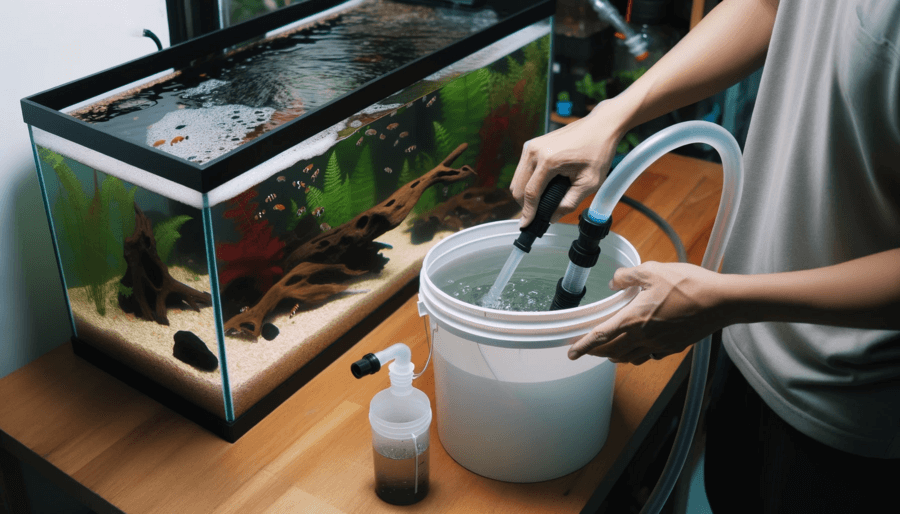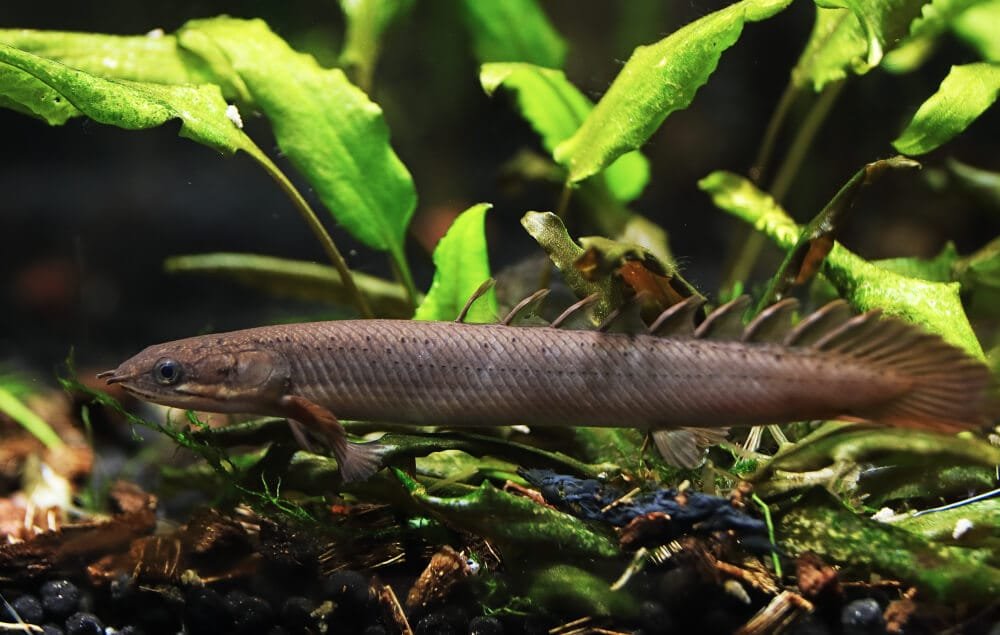Hey there! Have you ever found yourself wondering, “How often should I change the water in my aquarium?” Well, if you’re a new fish keeper or just looking for some tips to keep your aquatic friends happy and healthy, you’ve come to the right place. In this article, we’ll look at the importance of regular water changes, factors that influence the frequency, and some helpful guidelines to ensure your aquarium stays in tip-top shape. So, let’s dive right in and find out the perfect rhythm for refreshing that H2O!
Factors to Consider
Size of the Aquarium
The size of your aquarium is an important factor to consider when determining how often to change the water. Smaller aquariums tend to accumulate waste and toxins more quickly than larger ones. As a general rule, smaller aquariums should have more frequent water changes compared to larger ones.
Number and Size of Fish
The number and size of fish in your aquarium also play a role in determining the frequency of water changes. More fish in a tank means more waste and a higher bioload. Larger fish tend to produce more waste than smaller ones. If you have a crowded tank or large fish, you may need to change the water more frequently to maintain water quality.
Type of Filtration System
The type of filtration system you have in place can affect the frequency of water changes. A high-quality filtration system can effectively remove waste and maintain water quality, reducing the need for frequent water changes. On the other hand, if your filtration system is not up to par, you may need to change the water more often to compensate for its limitations.
Water Test Results
Regularly testing the water parameters in your aquarium is essential for maintaining a healthy and balanced aquatic environment. Factors such as ammonia, nitrite, nitrate levels, pH, and alkalinity should be monitored regularly. If the test results show high levels of toxins or imbalance, more frequent water changes may be necessary.
Determining Water Change Frequency
General Guidelines
While there are general guidelines for water change frequency, it is important to remember that each aquarium is unique and may require adjustments based on specific circumstances. As a general rule of thumb, a 25% water change every two to four weeks is a good starting point for most aquariums. However, this frequency can be increased or decreased based on the factors mentioned earlier.
Observing the Fish
One of the best ways to determine if your aquarium needs a water change is by observing your fish. If they appear lethargic, stressed, or exhibit unusual behavior, it may be an indication that the water quality has deteriorated. Regular water changes can help alleviate these symptoms and provide a healthier environment for your fish.
Measuring Water Parameters
Regularly testing the water parameters is crucial in assessing the need for a water change. Elevated levels of ammonia, nitrite, or nitrate can be harmful to fish and indicate the need for a water change. In addition, changes in pH or alkalinity can also be indicators of the need for a water change. Monitoring these parameters will help you make informed decisions about the frequency of water changes.
Considering Tank Maintenance
Another factor to consider when determining water change frequency is the overall maintenance of your tank. Regular cleaning of tank accessories such as filters, heaters, and decorations can help maintain water quality and reduce the need for frequent water changes. If you are diligent in maintaining a clean and well-maintained tank, you may not need to change the water as often.
Water Change Procedure
Gathering Necessary Supplies
Before starting the water change process, gather all the necessary supplies. These may include a siphon or gravel vacuum, a water conditioner to treat tap water, clean buckets or containers, and a clean cloth or sponge for cleaning tank accessories. Having all these supplies readily available will make the water change process smoother and more efficient.
Preparing New Water
When preparing new water for your aquarium, it is crucial to treat the tap water with a water conditioner to remove any chlorine or chloramine that may be present. Follow the instructions on the water conditioner bottle for the appropriate dosage. It is also important to match the temperature and pH of the new water to the existing aquarium water to avoid shocking the fish.
Removing Old Water
To remove the old water from the aquarium, use a siphon or gravel vacuum. Place one end of the siphon or vacuum in the tank and the other end in a clean bucket or container. Start the siphon action by sucking on the end of the tube until the water starts flowing. Move the siphon or vacuum around the tank to remove debris and waste from the substrate. Continue removing water until the desired amount has been removed.
Cleaning Tank Accessories
While the water change process is underway, take the opportunity to clean tank accessories such as filters, heaters, and decorations. Gently rinse these items in old tank water to remove any accumulated debris or algae. Avoid using soap or chemicals as they can be harmful to fish. Once clean, place the accessories back into the tank, ensuring they are properly reassembled and functioning.
Frequency Recommendations for Different Aquariums
Small to Medium Freshwater Aquariums
For small to medium-sized freshwater aquariums, a 25% water change every two to four weeks is generally recommended. However, if the tank is heavily stocked or has larger fish, more frequent water changes may be necessary. The key is to monitor the water parameters and observe the fish to determine if adjustments to the frequency are needed.
Large Freshwater Aquariums
In the case of large freshwater aquariums, a 10-15% water change every two to four weeks is a good starting point. However, it is important to assess the bioload and specific needs of the fish in the tank. If there are a significant number of fish or if they are large and produce more waste, more frequent water changes may be required.
Saltwater Aquariums
Saltwater aquariums generally require more frequent water changes compared to freshwater aquariums. A 10-20% water change every two weeks is a common recommendation. Saltwater aquariums have additional considerations such as maintaining proper salinity levels and mineral content, which may require more frequent monitoring and adjustments.
Reef Tanks
Reef tanks, which house corals and other invertebrates, have specific water quality requirements. Regular water changes are crucial for maintaining stable water parameters and nutrient balance. In general, a 10% water change every two weeks is a good starting point for reef tanks. However, close monitoring of water parameters and the specific needs of corals and invertebrates is essential to ensure optimal conditions.
Benefits of Regular Water Changes
Removal of Excess Nutrients
Regular water changes help remove excess nutrients from the aquarium, including nitrates and phosphates. These nutrients can accumulate over time and contribute to algae growth or poor water quality. By replacing a portion of the water with fresh, clean water, you reduce the nutrient load and maintain a healthier environment for your fish.
Maintaining Water Quality
Water changes are crucial for maintaining water quality in aquariums. As fish produce waste, toxins such as ammonia and nitrite can build up, which can be harmful to fish. Regular water changes help dilute and remove these toxins, ensuring a safe and healthy living environment for your aquatic pets.
Preventing Fish Diseases
Poor water quality is a leading cause of fish diseases and infections. By performing regular water changes, you reduce the risk of pathogens and bacteria proliferating in the tank. Additionally, the removal of waste and debris helps prevent the accumulation of harmful substances that can compromise the immune system of your fish.
Enhancing Fish Coloration
Regular water changes can also contribute to vibrant and healthy fish coloration. By maintaining optimal water parameters and reducing the accumulation of waste, fish are less stressed and can display their natural colors more prominently. Bright and vibrant fish colors are not only visually appealing but also a sign of good health.
Potential Risks and Concerns
Stress for Fish
While water changes are necessary for maintaining a healthy aquarium, they can also cause stress to fish. Sudden changes in water parameters or temperature can be detrimental to fish health. To minimize stress, make sure the new water matches the temperature and pH of the existing water and avoid making drastic changes to the tank environment.
Imbalance in Water Parameters
In some cases, frequent water changes can lead to imbalances in water parameters. For example, if you have soft water and continuously replace it with hard water, it can disrupt the delicate balance your fish are used to. Regularly monitor the water parameters and make adjustments as necessary to prevent imbalances.
Disrupting Beneficial Bacteria
Aquariums rely on beneficial bacteria to convert harmful ammonia into less toxic nitrate. However, excessive water changes can disrupt the bacterial colonies, potentially causing a spike in ammonia levels. To avoid this, consider using a bacterial supplement to help establish and maintain a healthy bacterial population in the tank.
Introducing New Contaminants
When performing water changes, it is important to ensure that the new water is free from contaminants. Chlorine and chloramine are commonly found in tap water and can be toxic to fish. Treating the tap water with a water conditioner is essential to remove these contaminants and make the water safe for your fish.
Tips for Successful Water Changes
Maintaining a Schedule
Establishing a regular schedule for water changes is key to maintaining a healthy aquarium. Consistency is important to ensure you perform water changes at the appropriate intervals. Set reminders or alarms to help you stay on track and make water changes a regular part of your aquarium maintenance routine.
Using a Siphon or Gravel Vacuum
Investing in a siphon or gravel vacuum is highly recommended for efficient water changes. These tools allow you to remove debris from the substrate while extracting old water. By removing waste from the gravel or sand, you not only improve water quality but also reduce the likelihood of harmful bacteria buildup.
Avoiding Overfeeding
Overfeeding is a common mistake that can contribute to poor water quality and the need for more frequent water changes. Only feed your fish the amount they can consume within a few minutes. Excess food that remains uneaten will decompose and produce ammonia, leading to water quality issues.
Quarantining New Fish
When introducing new fish to your aquarium, it is essential to quarantine them before adding them to the main tank. This helps prevent the introduction of diseases or parasites that can harm the existing fish. Quarantine tanks should have their own filtration system, and fish should be observed for any signs of illness before being introduced to the main tank.
Conclusion
Regular water changes are a crucial aspect of aquarium maintenance. By considering factors such as the size of the aquarium, the number and size of fish, the type of filtration system, and water test results, you can determine the appropriate frequency for water changes. Following the recommended procedures and guidelines, such as gathering necessary supplies, preparing new water, removing old water, and cleaning tank accessories, will ensure a smooth water change process. The benefits of regular water changes include nutrient removal, maintaining water quality, preventing fish diseases, and enhancing fish coloration. However, it is important to be aware of potential risks, such as fish stress, imbalances in water parameters, disruption of beneficial bacteria, and introducing new contaminants. By implementing tips such as maintaining a schedule, using a siphon or gravel vacuum, avoiding overfeeding, and quarantining new fish, you can ensure the success of your water changes and the overall health and vitality of your aquarium.




